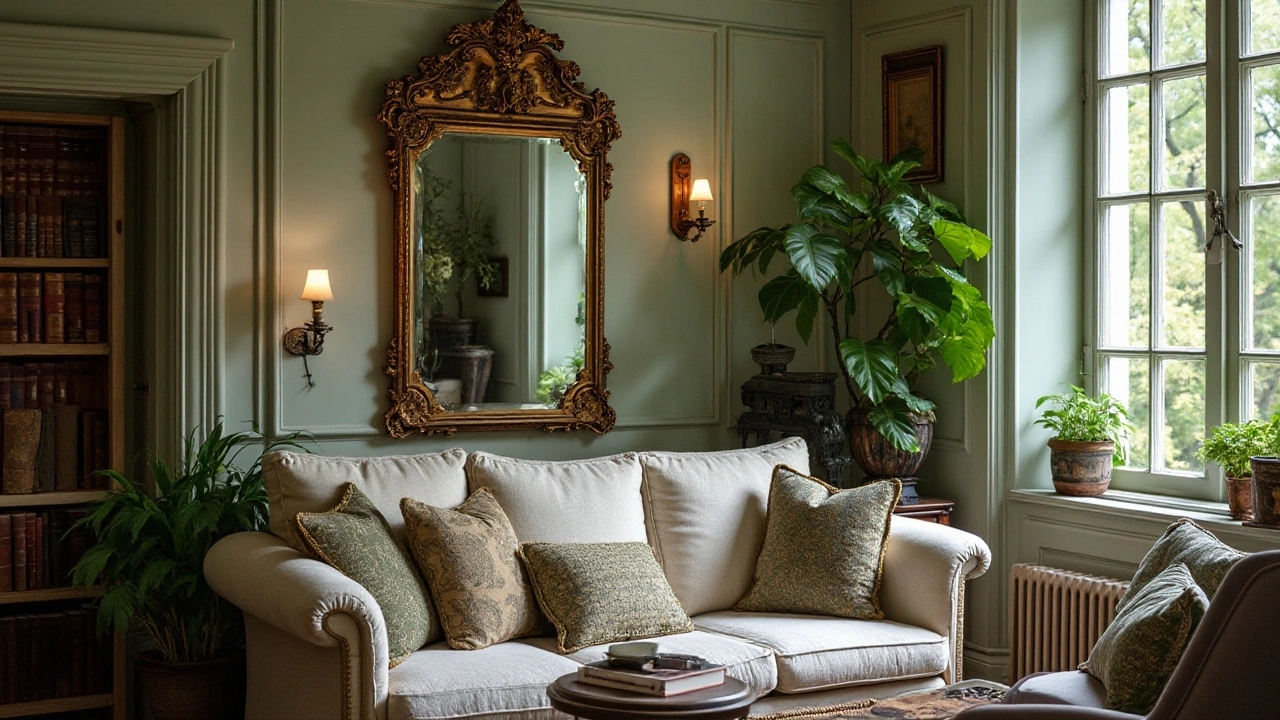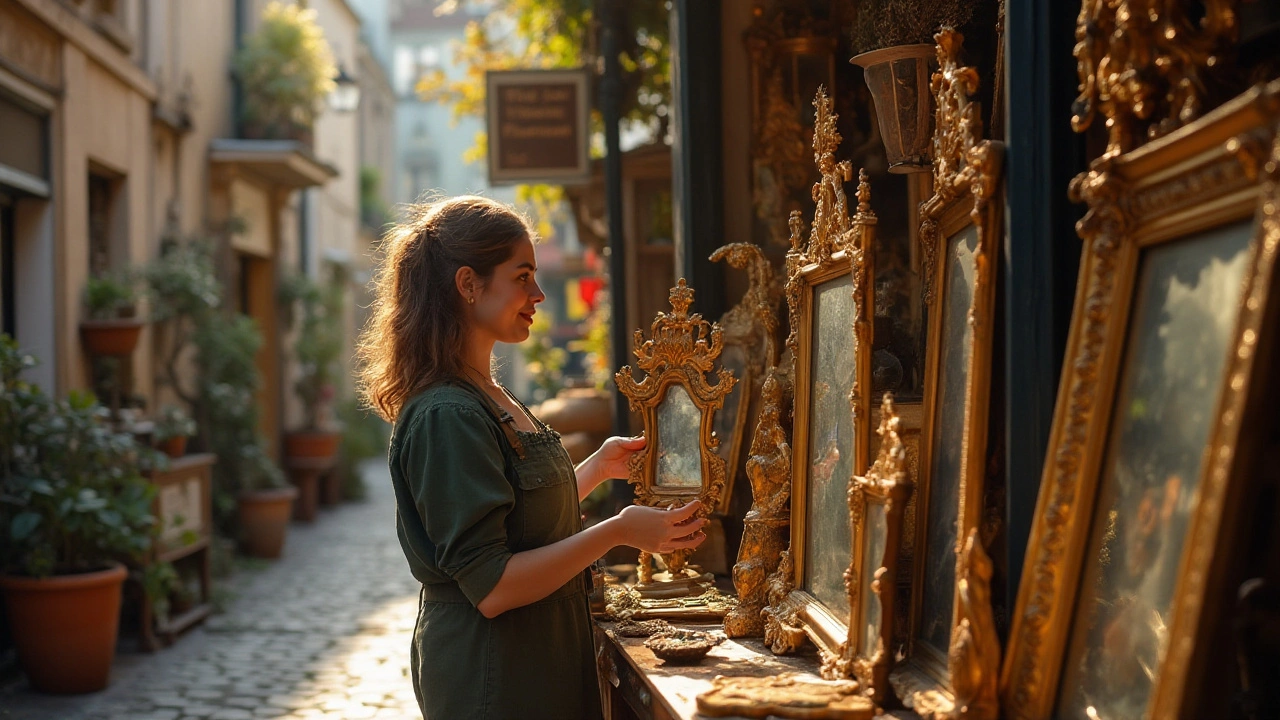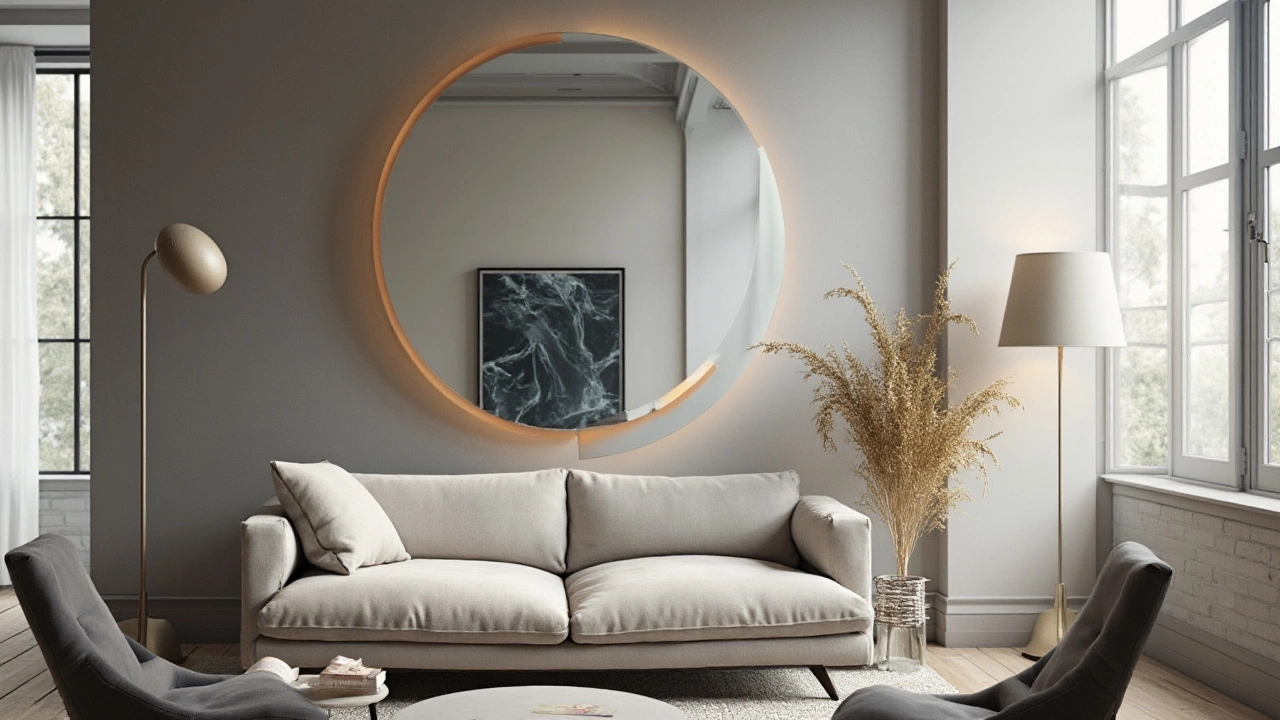Exploring the Value of Antique and Modern Mirrors
 Jan, 11 2025
Jan, 11 2025
In the realm of home decor and functionality, mirrors hold a unique place. They're not just for checking reflections; mirrors have a story to tell, a history that stretches back through the ages. From ancient hand-crafted pieces that adorned the walls of nobility to sleek, modern designs that grace contemporary spaces, mirrors offer more than meets the eye.
As we delve into the world of mirrors, we will uncover what factors into their value, both in terms of monetary worth and aesthetic significance. Whether you're a collector seeking rare finds or a homeowner looking to add character to your environment, understanding the nuances of mirror value can be illuminating. Let's embark on this reflective journey to discover if mirrors are truly worth the investment.
- History of Mirrors
- Factors Affecting Mirror Value
- Antique Mirrors
- Modern Mirrors
- Evaluating Mirror Worth
History of Mirrors
Mirrors have entranced humans for thousands of years, evolving from simple reflective surfaces to the ornate, decorative pieces we appreciate today. The journey of mirrors begins as early as 6000 BC, with the first known examples being polished stones like obsidian used by the people of Anatolia, now modern-day Turkey. These primitive mirrors reflected a hauntingly fuzzy image, yet they marked a significant leap in human curiosity about self-reflection and appearance.
As we move through history, the ancient Egyptians in 2900 BC crafted mirrors from polished copper, a significant improvement in reflective quality. These metallic mirrors were often adorned with intricate handles and were considered luxurious items owned primarily by the elite. The influence of mirrors spread across cultures, with the Chinese creating bronze mirrors as early as 2000 BC. These versions were cast and polished with great skill, again signifying status and wealth.
The turning point in mirror-making occurred around the first century AD in Roman times when glass began to be used as a substrate. Still rare, these glass mirrors were backed with lead, offering a clearer reflection than previous methods. The Romans’ ingenuity laid the groundwork for more advancements. However, it wasn’t until the Middle Ages that Venetians revolutionized the process by perfecting the method of coating glass with a mixture of tin and mercury. In the Renaissance period, Venetian mirrors became the gold standard for quality, sought after by affluent collectors worldwide.
In a quote that encapsulates the allure of mirrors during this era, historian Julius von Schlosser noted,
"The mirror stands as a blend of truth and illusion, a testament to humankind's endless fascination with appearance."This seductive combination of beauty and mystery ensured mirrors’ popularity and the continuation of innovations in their creation.
By the 17th century, France had taken over from Venice as the leader in mirror production with the establishment of the Manufacture Royale de Glaces de Miroirs, famously producing the dazzling Hall of Mirrors in the Palace of Versailles. Industrial techniques in the 19th century democratized mirror ownership, allowing more people access to what had once been a symbol of prestige. Today, the legacy of these historical innovations persists, influencing both the design and technology of modern mirrors. As we peer into these reflective surfaces, we are not only seeing ourselves but also glimpsing a rich history where art, science, and humanity converge.
Factors Affecting Mirror Value
When evaluating the value of a mirror, several factors come into play. One of the principal aspects is its age. Older mirrors, especially those classified as antiques, often possess significant monetary value due to their rarity and the craftsmanship typical of earlier eras. These mirrors reflect not just the images of their admirers but also the cultural and artistic trends of their time. For example, mirrors from the Baroque period are renowned for their elaborate frames and intricate carvings, revealing the opulence of the 17th and 18th centuries. These unique attributes of different historical periods can make them highly sought after by collectors and enthusiasts.
Another key factor is the craftsmanship and materials used in a mirror's creation. Mirrors with frames made from materials like gilded wood, bronze, or even mosaic finishes tend to be more valuable. Craftsmanship plays a critical role here, as the precision and intricacy of detail in frame design can greatly enhance a mirror's desirability and worth. Some mirrors might also have historical marks or stamps from famous artisans, which can significantly add to their market value. It's not just about the reflective surface; the value lies in the essence and excellence with which the mirror was crafted, telling stories of human ingenuity and creativity across ages.
The condition of a mirror is also immensely important in determining its value. While some collectors appreciate the natural patina and signs of age that come with older pieces, severe damage such as deep scratches, cracked glass, or broken frames can detract from its value. Mirrors in pristine or well-preserved condition are more appealing and typically fetch higher prices. According to Artemisia Kelshall, a respected art curator, "The value of historical artifacts like mirrors can hinge entirely on their condition, akin to rare pottery and paintings." This underscores the need for careful preservation and maintenance of such treasures.
Interestingly, the provenance or history of ownership can also enhance the worth of a mirror. A strong provenance, such as a mirror that once belonged to a royal collection or famous individual, can significantly elevate its value due to its historical significance and the story it tells. Mirrors with a documented past intrigue collectors seeking not just an object, but a piece of history with a tale to unfold. Additionally, mirrors that can be traced back to renowned manufacturers or artisans are often valued higher, as they carry with them a mark of quality and prestige.
Finally, current trends and the market demand can affect the value of mirrors. As tastes in home decor evolve, certain styles become more desirable. For instance, mid-century modern and Art Deco mirrors have seen a resurgence in popularity due to their timeless design and ability to blend seamlessly into contemporary interiors. This fluctuating demand can affect the market price, making it crucial to stay informed about trending designs and styles that generate higher interest and thus command more value.

Antique Mirrors
The allure of antique mirrors lies in their ability to serve as both functional objects and profound storytellers of bygone eras. Each piece is a window into the past, offering a glimpse into the design sensibilities and craftsmanship of its time. The history of mirrors dates back to ancient civilizations, where polished stones like obsidian were used by the wealthy elite to glimpse their own reflections. It was not until the Renaissance that mirrors, as we recognize them today, began to emerge in Europe, crafted meticulously with silvered glass surfaces.
Antique mirrors are often regarded as coveted items among collectors, not just for their beauty but for the intricate artistry involved in their creation. These mirrors were handcrafted by skilled artisans, whose work reflected the artistic and cultural movements of their era. For instance, the Baroque period saw mirrors embedded in grandiose gilded frames, adorned with swirling designs and motifs that resonated with the opulence of the time. In comparison, Georgian and Regency styles offer a more restrained elegance, often featuring delicate carvings and understated embellishments.
The value of an antique mirror is determined by several factors, starting with its provenance. Mirrors with documented histories, tracing back to notable owners or events, can fetch significantly higher prices at auctions. Age is another crucial determinant, with older mirrors often considered more valuable, especially if they remain unchanged. Condition plays an essential role too; while some patina can enhance its charm, extensive restoration may diminish its authenticity and reduce its appeal to purists.
Collectors often seek out antique mirrors as investment pieces, but their worth is not solely monetary. They're valued for their ability to transform spaces, infusing rooms with a sense of history and elegance unmatched by modern counterparts. Many enthusiasts argue that the imperfections of old glass, with its ripples and slight distortions, add character, setting them apart from their flawless, contemporary versions. Renowned decorator Elsie de Wolfe once stated, "A house should be a home, a companionable place—a place to share joys and sorrows, to converse and confront, to talk, to relax, to think and to entertain." Her words encapsulate the spirit in which antique mirrors are often appreciated.
Did you know that the largest known antique mirror was discovered in the historical Palais des Glaces, featuring an extraordinary height of eleven feet?
According to antiques expert Judith Miller, "Antique mirrors are more than mere consolidation of glass, metal, and wood; they are portals to the eras they originate from, whispering tales through each tarnish and frame embellishment."
As today's market for antiques remains robust, understanding how to identify authentic antique mirrors becomes invaluable. Authentic ones often have subtle signs of aging, such as small imperfections or 'foxing'—the term used to describe the spots and marks on antique mirror backing. Prospective buyers and collectors are advised to examine these characteristics closely, considering consultation with appraisers when necessary to confirm authenticity. Moreover, in some cases, antique mirrors have concealed artwork within their frames, making them even more extraordinarily rare finds, hiding stories yet to be unveiled.
Modern Mirrors
The landscape of modern mirrors is as varied and dynamic as the people who admire and use them. In today's world, mirrors are not just about looking at oneself; they are a fundamental design element, adding depth and light to spaces that might otherwise seem ordinary. From boutique mirror makers to large retail brands, the array of styles is astonishing, embracing both function and flair. For the minimalist, there are sleek frameless options that blend seamlessly into walls, creating an illusion of more space. And for those who love to make a statement, options abound with bold frames and whimsical shapes that turn a reflective surface into a piece of art.
Today’s mirrors are often the result of advanced manufacturing techniques and innovative materials, allowing for a variety of designs that were previously unimaginable. Manufacturers are utilizing materials like acrylic and tempered glass, sometimes incorporating technology directly into the mirror. Intelligent mirrors are an emerging trend; these often include features such as integrated lighting, anti-fog capabilities, and smart home connectivity. They blend seamlessly into the household, offering features that go beyond simple reflection. Imagine getting your daily news briefing or checking the weather forecast as you brush your teeth in front of your bathroom mirror. These features add distinct value, drawing a line between traditional and modern mirrors.
In today’s eco-conscious world, the sustainable production of mirrors is a growing consideration. Many manufacturers prioritize eco-friendly processes, using recycled materials and reducing energy consumption during production. This shift not only appeals to environmentally minded consumers but also enhances the intrinsic value of the mirrors produced under such practices. Additionally, there is a renewed interest in craftsmanship, with artisanal mirrors embodying a blend of traditional skills and contemporary design. These pieces often command high prices because they are viewed as unique, well-crafted works of art, combining heritage with modernity in an eco-friendlier way.
"The mirror is a canvas on which life's reflections are created, highlighting the beauty of transformative design," says renowned interior designer Emily McQueen, emphasizing the importance of integrating modern mirrors into personal and public spaces.
When it comes to decorating with modern mirrors, there are several effective strategies. Mirrors can be used to enhance natural light in a home by placing them opposite windows. For accentuating a room’s features or creating an illusion of space, a group of smaller mirrors can be artfully arranged, merging utility with style. Pivotal to note is the consideration of mirror placement. Strategic positioning can effectively transform the ambiance of a room and change perceptions of space, providing more than just a reflection but a profound impact on the interior landscape.

Evaluating Mirror Worth
When it comes to determining the worth of a mirror, several factors come into play, much like the intricate craftsmanship involved in making mirrors themselves. The process is far from straightforward, requiring a nuanced understanding of both historical and modern influences. One significant aspect is the mirror's age, where antique pieces often carry a higher market value due to their rarity and the story they tell of bygone eras. These mirrors reflect more than just your image; they echo a slice of history, woven into their ornate frames and the subtle imperfections of hand-ground glass.
A mirror's provenance can heavily influence its price as well. Mirrors with a documented history or association with notable figures can command a premium. Artisanship is another crucial element, as intricately carved wooden or gilded frames are invaluable to collectors and decor aficionados alike. The artistry and technique behind these designs often speak volumes about the cultural context in which they were created, shedding light on the evolving tastes and decorative styles of different periods. Materials used in making the mirror, such as rare woods, fine metals, or even inlaid gemstones, further affect its value, appealing to those who find beauty in the details.
"A mirror reflects not only our image but the society and times in which it was crafted." - A renowned antique appraiser once said.
On the other side of the spectrum, we have modern mirrors that embody contemporary design principles, where value is measured differently. Here, the worth might be driven by a designer brand, the latest technology that adds functionality, or innovative aesthetic features that push the boundaries of traditional decor. Full-length touch screen mirrors, smart mirrors with integrated lighting, and those featuring heated anti-fog surfaces are examples of how technology is entwining with decor. These features add both convenience and luxury, making modern mirrors not just utilitarian objects, but also statements of lifestyle and taste.
Often, when seeking to appraise a mirror, expert evaluation is necessary. Professionals utilize a keen eye for detail and vast knowledge of art history and market trends to determine a mirror's value. They consider aspects like the condition of both frame and glass, checking for restoration or repairs which might impact its authenticity and historical integrity. Mirrors with original glass that features unique aging characteristics, such as subtle ghosting or color variations, can actually see their value increase, as these qualities are coveted by collectors for their genuine charm.
For those curious about the monetary value of their mirrors, attending auctions, visiting antique shows, or consulting with established appraisers can provide insights into the current market landscape. Understanding what potential buyers are drawn to can offer a clearer picture of a mirror's worth. Whether a mirror belonged to a notable lineage or is a representation of modern innovation, the factors that influence its value make any mirror more than a mere household item; they become a storytelling piece within any home or collection.